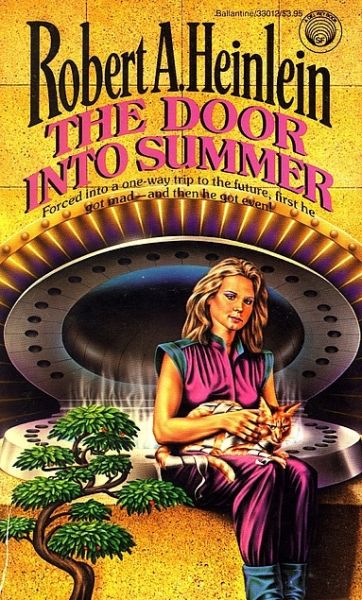Millennial Review III: The Door into Summer by Robert A. Heinlein (1957)
The Door Into Summer
By Robert A. Heinlein

18 Jan, 2000
0 comments
The Door into Summer 1
Robert A. Heinlein
copyright 1957
291 pages
A note about cover art: the edition I am reading [Del Rey, 1986] has really awful art. Not sure the artist has any experience drawing people but the cat is Just Plain Wrong. I like what appears to be a large waffle iron masquerading as a cold sleep chamber, though.
Synopsis: In 1970, Dan Davis invents several useful household robots, based on technology invented during WWIII. He is swindled by his fiancee and business partner, then sent on a one way trip via cold sleep to the year 2000. After some initial problems fitting in, Davis finds gainful employment while continuing to research what happened to his company, his business partner, his business partner’s step-kid and his fiancee. Eventually, after having the satisfaction of seeing his ex-fiancee ruined by time and indulgence [In language really very similar to that used to describe Mrs. Farnham in Farnham’s Freehold , actually], he discovers an unreliable method of traveling through time, makes his way to 1970 again, rights the wrongs done to him in that year [including saving his cat] and then travels ‑back- to 2000 where he marries his partner’s step-daughter, who we discover has centered her life around eventually marrying Davis in 2000.
I had such fond memories of this book. The problem is, a man hitting on an 11 year old girl was a lot less creepy when I was 11 than it is now that I am almost 40. I also never noticed how badly Davis handles interpersonal problems and how completely arrogant he is with other people: he has more respect for his cat than his fiancee, for example and a big part of the reason she can con him is because it never occurs to him that she might not do what he tells her to: he gives her voting stock but assumes she’ll never use it. As far as I can tell, Davis really thinks the universe revolves around him.
The point of divergence from our history is fairly early: WWIII happens in 1965, cold sleep comes in before that and solid state electronics never seems to have been invented, displaced by a very useful vacuum tube. By 1970, the world is unlike ours. By 2000, the differences are even more striking. Among other things, they have a limited form of antigravity and an even more limited method of time travel. RAH guesses wrong about what major changes were going to happen between 1957 and 2000, but I think he had the magnitude of the changes about right.
There are some odd gaps in applications of technology, though: the same device which makes robots work should be applicable to mathematical operation but isn’t used to replace slide rules. The time machine has the limitation that it has to balance a mass sent one way into time with another object of identical mass sent the same distance in time in the other direction. There’s no reason why the man who owns it could not get very, very rich by sending two copies of the financial pages of his newspaper a few weeks in either direction.
I am rather happy that WWIII never happened on schedule. I’ll happily forgo the moon colonies in exchange for not being radioactive dust downwind of London, England.
Not much of a fun read, sadly. The main character is really very unpleasant in ways I can’t ignore any more.
1: And would The Door in Sumer have been a great alternate name for Island in the Sea of Time or what?
